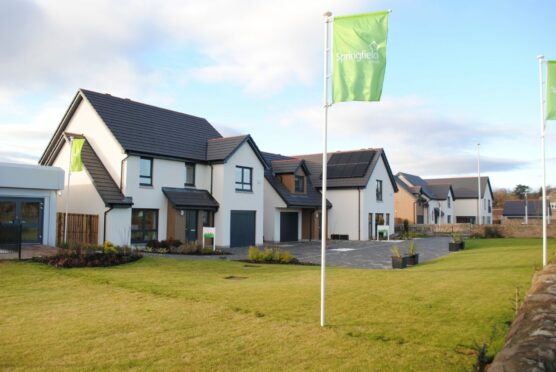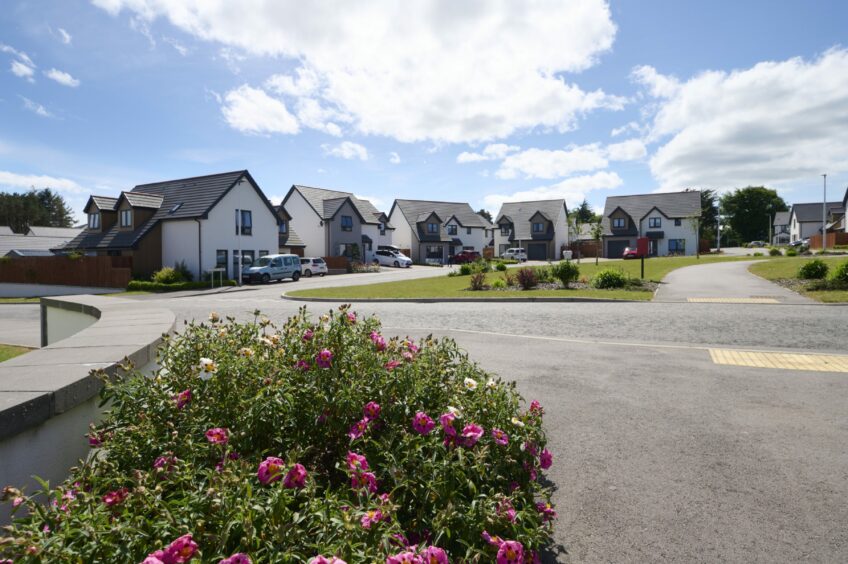Scottish housebuilder Springfield Properties has overcome turmoil in the market to net record annual sales.
Shares in the London-listed company are up nearly 7% after it reported year-on-year revenue growth of 28%.
But the company – whose current developments include Drakies in Inverness, Glassgreen Village in Elgin and Dykes of Gray in Dundee – has had a torrid year on the Alternative Investment Market.
At 69p, the stock is currently worth about one-third less than its value of £1.02 on February 7.
Annual revenue up by more than £70m
Results for the firm’s 2022-23 trading year will be announced in September.
But in a trading update today the firm said sales for the year to May 31 2023 were likely to come in at around £330 million, compared with £257.1m in 2021-22.
Revenue has been boosted by average selling prices for Springfield’s private sector homes jumping from £245,000 to about £290,000 since a year ago.
Springfield, said its record sales were driven by full-year contributions from Inverness-based Tulloch Homes and central belt business Mactaggart & Mickel Homes (MMH), acquired in late 2021 and 2022 respectively.
Higher value MMH properties helped push up the average selling price.
Springfield’s profit margins have likely taken a hit in a weaker UK housing market
Pre-tax profits for 2022-23 are likely to be in line with market expectations, said Springfield, whose headquarters are split between offices in Elgin and Stirling.
Margins are weaker than a year ago and some experts are predicting an 18% drop in profits for Springfield in 2022-23. But they also see potential for earnings recovery in the current trading year as inflation eases and market conditions improve.
Springfield reported annualised cost savings of £3m and a near-8% drop in net debt since November 30, to £68m.
It also highlighted a “high quality” land bank of 16,300 plots at May 31, with more than half having planning permission. These sites have a gross development value of £3.5 billion.
Chief executive Innes Smith said: “Against a challenging market backdrop, we delivered our highest annual revenue, reflecting our acquisitions as well as organic growth in private housing. While our margins were impacted by significant build cost inflation, particularly in affordable housing, we took decisive action to address this.
“We remain cautious about the near-term outlook, particularly given the softening in demand following the increase in rates by the Bank of England to 5%. We are closely monitoring the economy and buyer behaviour in both the housing and land market, and carefully managing our activities to limit our exposure in the slower sales environment.
“This will also ensure that we can respond quickly when normalised demand returns.”
We remain cautious about the near-term outlook, particularly given the softening in demand following the increase in rates by the Bank of England to 5%.”
He added: “With over half of our large, high-quality land bank having planning permission, we are well-positioned for when market conditions improve. We are also encouraged that the Scottish Government has now increased its affordable housing investment benchmarks, supporting the viability of affordable housing projects going forward.
“The fundamentals of the housing sector in Scotland remain strong. There is an undersupply of housing, which is being exacerbated by the current conditions, and there is greater affordability in Scotland compared with the UK as a whole.”
Springfield’s longer-term plans for building affordable homes in Scotland still on hold
Springfield has paused entering long-term fixed price contracts for affordable homes amid uncertainty in the market.
But it said the government’s decision to raise investment benchmarks for the sector should allow housing associations to increase the price of contracts and kick-start new building programmes.
Read more: How Springfield Properties pulled off its £56.4m swoop for Tulloch Homes


